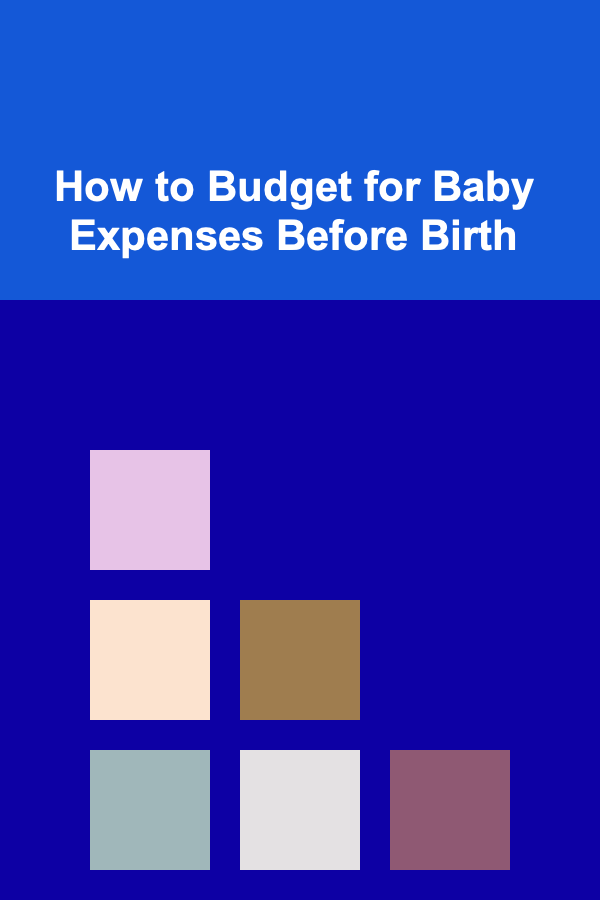
How to Budget for Baby Expenses Before Birth
ebook include PDF & Audio bundle (Micro Guide)
$12.99$11.99
Limited Time Offer! Order within the next:

Welcoming a new baby into your family is one of life's most joyous moments, but it also comes with a range of financial responsibilities. Preparing for these expenses well in advance can ease the financial stress that often accompanies the arrival of a baby. While every family's financial situation is different, creating a baby expense budget before birth is crucial for ensuring that you're ready to manage the costs of parenting from the very beginning.
In this article, we will explore how to budget for baby expenses before birth, taking into consideration everything from prenatal care to baby gear, and offer tips for managing the financial changes that come with adding a little one to your family.
Understand the Overall Cost of Having a Baby
Before diving into the specifics, it's essential to have an overview of the potential costs you can expect when you're preparing for a baby. On average, parents in the U.S. spend between $12,000 to $14,000 in the first year of a baby's life, including prenatal care, delivery costs, and baby essentials. However, the cost can vary greatly depending on your location, healthcare plan, and personal choices.
Key Baby Expenses
- Prenatal Care: This includes doctor visits, tests, and screenings throughout the pregnancy. The cost will depend on your insurance coverage, location, and any complications that may arise.
- Delivery: Hospital bills for labor and delivery can range from a few thousand dollars to tens of thousands, depending on whether you have a natural birth, a C-section, and if there are any complications.
- Baby Gear: This includes items like cribs, car seats, strollers, clothing, diapers, and baby furniture.
- Health Insurance and Maternity Leave: If you're planning to take maternity leave, you may need to factor in the loss of income. Additionally, ensure that your insurance covers the baby after birth.
- Childcare: If you plan to return to work after maternity leave, childcare will likely become a significant ongoing expense.
While the initial year can be expensive, the good news is that many of the upfront baby costs are one-time expenses, and the ongoing expenses will become more predictable over time. Let's break down the process of budgeting for these expenses step by step.
Estimate Prenatal and Delivery Costs
The first major expense to consider when budgeting for baby expenses before birth is prenatal care and delivery. Your healthcare plan will have a significant impact on how much you pay out-of-pocket, so it's important to understand your insurance coverage and out-of-pocket costs as early as possible.
Prenatal Care Expenses
Prenatal care typically includes regular visits to your doctor, blood tests, ultrasounds, and any other screenings that may be required. If you're seeing an obstetrician, your plan may cover these visits, but you will likely still need to cover co-pays, deductibles, or co-insurance. For those without insurance, prenatal care costs can range from $1,500 to $5,000 or more, depending on the complexity of the pregnancy.
Action Steps:
- Review your health insurance plan: Ensure that prenatal care, maternity services, and newborn care are covered.
- Consider out-of-pocket costs: Even with insurance, you may have to pay deductibles, co-pays, or coinsurance.
- Plan for screenings and tests: Factor in the costs for necessary prenatal screenings such as ultrasounds, glucose tests, and blood work.
Delivery Expenses
Delivery costs can vary greatly depending on the location, type of birth, and any complications. In the U.S., hospital deliveries typically range from $5,000 to $15,000 without insurance. A cesarean section will likely cost more than a vaginal birth.
For those with health insurance, you will typically pay co-pays or out-of-pocket costs, depending on your plan's coverage. Even with insurance, it's essential to know your plan's maternity care benefits and any potential out-of-pocket costs.
Action Steps:
- Research delivery costs: Find out the costs for both vaginal and C-section deliveries at the hospital or birthing center where you plan to give birth.
- Know your insurance coverage: Understand how much of the delivery cost will be covered by your insurance plan.
- Consider additional services: Don't forget about post-delivery care, including breastfeeding consultations, lactation support, and any special needs the baby may have.
Budget for Baby Gear
Baby gear is one of the most significant one-time expenses new parents face. The costs can vary depending on personal preferences and whether you choose to buy new or secondhand items. Essential baby gear includes a crib, car seat, stroller, diapers, and clothing, among other items.
Crib and Nursery Furniture
A crib is one of the most important purchases you will make for your baby. Along with the crib, you will need a mattress, bedding, and possibly a changing table or dresser. The price range for a crib can vary widely, with basic cribs starting around $100 and high-end cribs reaching $1,000 or more.
Action Steps:
- Shop for deals: Consider buying a crib that will grow with your child, such as a convertible crib that can transform into a toddler bed.
- Safety first: Make sure all baby furniture meets current safety standards.
- Consider secondhand options: Gently used furniture can be a great way to save money.
Car Seat and Stroller
A car seat is an absolute necessity when bringing your baby home from the hospital. It's often one of the most expensive items on the baby gear list. Prices for infant car seats start around $100 and can go up to $400 or more, depending on the brand and features. Strollers range from $100 to $1,000, depending on the type and quality.
Action Steps:
- Buy a travel system: A travel system includes both a car seat and stroller and can often offer better value for money.
- Check for safety ratings: Always choose a car seat that meets current safety standards and fits your car.
- Consider used options: If you're on a tight budget, buying gently used baby gear can help save money.
Diapers and Baby Clothing
Diapers and baby clothing are recurring costs that will continue well beyond the first few months. On average, parents will spend $500 to $1,000 on diapers in the first year, depending on the brand and whether you use cloth or disposable diapers. Baby clothing costs can range from $200 to $500, depending on how many clothes you buy.
Action Steps:
- Sign up for diaper subscriptions: Many companies offer diaper subscription services that can save money and ensure you always have diapers on hand.
- Don't overbuy clothing: Babies grow quickly, so avoid buying too many clothes in advance. You may receive clothing as gifts once the baby is born.
- Consider cloth diapers: While more expensive initially, cloth diapers can save money in the long run if you plan to use them.
Healthcare for the Baby After Birth
Once your baby is born, you'll need to plan for ongoing healthcare costs, including pediatrician visits, vaccinations, and health insurance coverage for the baby.
Pediatrician and Checkups
After birth, your baby will need regular checkups to ensure that they are developing properly. These visits are typically covered by insurance, but you may still be responsible for co-pays or deductibles. Budgeting for these regular visits is important, as well as any special health needs your baby may have.
Action Steps:
- Review your pediatrician's fees: Some pediatricians charge additional fees for services such as vaccinations or sick visits.
- Factor in co-pays and deductibles: Even with insurance, you may still have to cover some out-of-pocket costs for pediatric care.
Plan for Maternity Leave and Childcare
Maternity leave and childcare costs can significantly impact your budget. Depending on where you live and your workplace policies, you may have limited paid maternity leave, or you may be required to take unpaid leave. Additionally, childcare expenses can be one of the largest ongoing costs for parents returning to work.
Maternity Leave
Maternity leave can be paid or unpaid, depending on your employer and location. In the U.S., paid maternity leave is not guaranteed, and many women rely on short-term disability insurance, savings, or a partner's income to cover the time off.
Action Steps:
- Understand your employer's maternity leave policy: Check with your HR department to understand your options for paid or unpaid leave.
- Plan your finances: If maternity leave is unpaid, create a savings plan to cover the time off work.
Childcare
Once you return to work, childcare can be a significant cost. In-home daycare, daycare centers, and nannies all have varying costs depending on your location and the level of care required. On average, parents can expect to pay $9,000 to $20,000 per year for childcare.
Action Steps:
- Explore childcare options: Research the costs of daycare centers, in-home care, and nannies to determine what fits your budget.
- Consider family help: If you have family members who are willing to help with childcare, this can be a cost-saving option.
Create a Savings Plan
Now that you've identified your baby-related expenses, it's time to create a savings plan to ensure you're financially ready for the costs of raising a child. Ideally, you should start saving as early as possible, ideally before pregnancy, but even during pregnancy, it's not too late.
Action Steps:
- Set up a baby fund: Create a separate savings account for baby-related expenses to keep your finances organized.
- Save regularly: Set up automatic transfers into your baby fund each month to build up your savings before the baby arrives.
- Review your budget: Adjust your current budget to account for baby-related expenses, reducing non-essential spending to free up money for savings.
Track Expenses and Adjust Your Budget
Once you've created your budget, it's important to track your spending as you go along and adjust your plan as necessary. Unexpected costs may arise, and some expenses may end up being less than anticipated.
Action Steps:
- Use budgeting apps: Apps like Mint or YNAB can help you track baby-related expenses and stay on budget.
- Be flexible: Adjust your budget as necessary to accommodate changes in your financial situation.
Conclusion
Budgeting for baby expenses before birth may seem overwhelming, but with careful planning and organization, you can ensure that you're financially prepared for the arrival of your little one. By understanding the costs associated with prenatal care, delivery, baby gear, and ongoing childcare, you can create a realistic budget and start saving early to reduce financial stress during this exciting time in your life. With a solid financial plan in place, you can focus on enjoying the journey into parenthood with peace of mind.
Reading More From Our Other Websites
- [Home Party Planning 101] How to Plan a Home Party: What Are the Best Tips for a Seamless Event?
- [Home Maintenance 101] How to Maintain Your Home's Garage Floor
- [Organization Tip 101] How to Repurpose Old Furniture for Kid Room Storage
- [Personal Care Tips 101] How to Use Makeup Primer to Create a Smooth Base for Powder Products
- [Home Cleaning 101] How to Clean and Maintain Your Ceiling Fans and Light Fixtures
- [Organization Tip 101] How to Design a Toy Closet that Works for You
- [Home Pet Care 101] How to Set Up an Indoor Pet Enrichment Station
- [Personal Investment 101] How to Analyze a Company's Financial Report: A Step-by-Step Guide for Beginners
- [Rock Climbing Tip 101] Fun Climbing Games and Activities to Keep Kids Engaged on the Wall
- [Scrapbooking Tip 101] DIY Design Ideas: Customizing Your Scrapbooking Paper Pads for Personalized Layouts

How to Create a Home Office That Inspires Productivity
Read More
How to Monetize Deep Learning Models in the Digital Marketplace
Read More
How to Prevent Noise Between Rooms with Simple Solutions
Read More
How to Set Up a Safe Space for Your Pet
Read More
The Art of Housekeeping: Creating a Welcoming and Spotless Environment Every Time
Read More
10 Tips for Blacksmithing with Recycled Materials
Read MoreOther Products

How to Create a Home Office That Inspires Productivity
Read More
How to Monetize Deep Learning Models in the Digital Marketplace
Read More
How to Prevent Noise Between Rooms with Simple Solutions
Read More
How to Set Up a Safe Space for Your Pet
Read More
The Art of Housekeeping: Creating a Welcoming and Spotless Environment Every Time
Read More